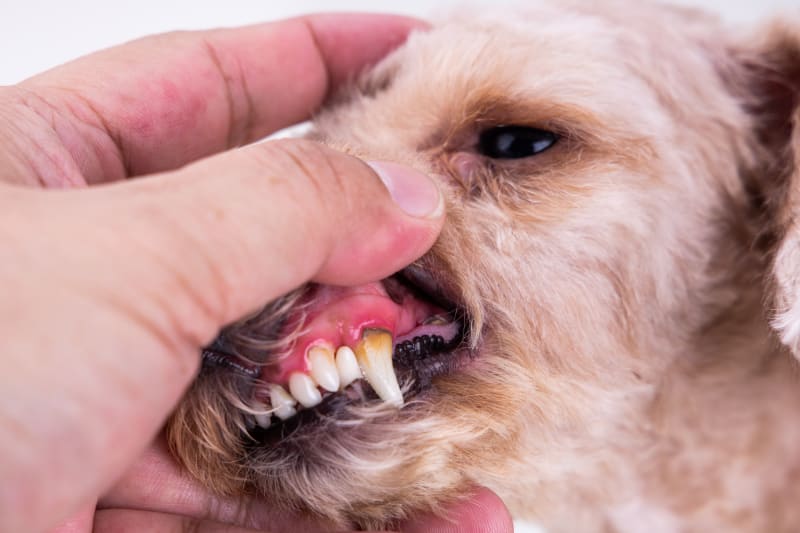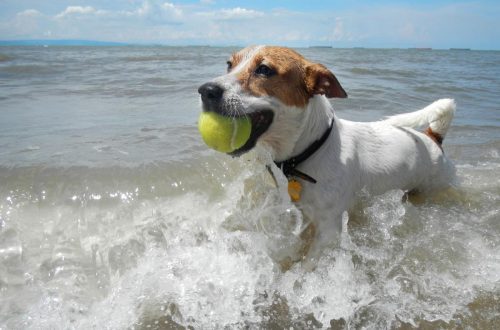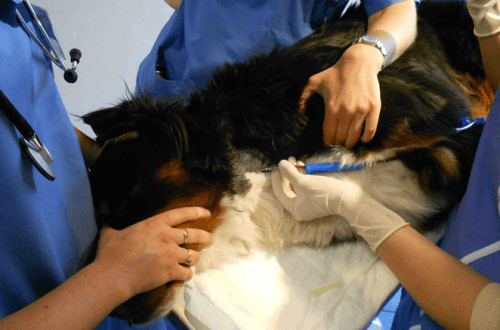
Periodontitis in Dogs: Symptoms and Treatment
Periodontal disease in dogs, also known as gum disease (periodontitis), is a serious problem. By age three, gum disease can affect most four-legged pets. Although there are usually no symptoms at first, as periodontal disease progresses, it can affect the dog’s teeth, gums, and jaw.
Despite the fact that these pathologies in dogs are very common, they can be treated and sometimes even prevented with the help of prevention.
Contents
What is periodontitis in dogs
This type of disease affects the periodontium, the tissues of the mouth that surround and support the teeth. Periodontitis in dogs is caused by a bacterial infection.
After eating, the bacteria begin to eat any food particles left in the pet’s mouth. They form a sticky white-grayish film called plaque. The dog’s immune system immediately recognizes plaque bacteria as foreign invaders, and the animal’s body sends white blood cells to fight off the intruder. But if plaque is left untouched, it will thicken and the bacteria will release toxins, causing the following effects:
- Inflammation or redness of the gums – gingivitis.
- Destruction of the gums.
- Destruction of the bone tissue around the teeth.
- Loss of teeth.
Complications of periodontitis in dogs.
One of the complications of periodontitis is a jaw fracture. Over time, inflammation caused by bacteria can eat away at the jaw bone, weakening it and leading to pathological fractures—that is, caused by disease rather than injury. This is especially true for dogs of small and miniature breeds.
Another complication is the formation of an oronasal (oronasal) fistula – a pathological opening between the mouth and the nasal cavity as a result of tissue erosion. This inflammatory complication of periodontitis can lead to chronic nasal discharge and infections.
Bacteria that live in a dog’s mouth can also enter the bloodstream and from there to the kidneys, heart, and liver. This can lead to increased strain on internal organs and other health problems.
Signs of Periodontitis in Dogs
Early signs of gum disease in dogs include bad breath, tartar – mineralized plaque, and a red, inflamed streak along the gum line. Owners rarely notice the first signs of periodontitis in dogs. By the time symptoms become noticeable, the gum disease is usually already advanced enough to cause pain to the animal.
Periodontitis in dogs: consequences
- Bleeding or red gums.
- Saliva with blood.
- Loose teeth.
- Seals in the mouth or under the eyes.
- Dropping gums.
- Nasal discharge or sneezing.
In addition, the dog may have difficulty taking food into its mouth, dropping it on the floor, or chewing on only one side. She can become shy and show her appearance that she does not want to be touched on the head.
Diagnosis of periodontitis
Many of the signs of this disease—reddened gums, plaque and tartar, loose or loose teeth—can be seen by a veterinarian during an oral examination. If there is a suspicion of periodontitis, he will recommend that the dog be brushed and x-rayed under general anesthesia for a comprehensive assessment of the condition of its oral cavity.
It is advisable to regularly examine the dog at the veterinarian for periodontitis once or twice a year. Early treatment will help keep your pet’s teeth. If a specialist advises dental care, you should follow his recommendations, even if everything seems to be in order with the pet.
How to Prevent Periodontitis in Dogs
There are several general recommendations of specialists that will help in the prevention of the disease:
Regular brushing of teeth. Pets benefit from brushing their teeth twice a day. This procedure helps to reduce the formation of plaque and get rid of bacteria. Most dogs learn to brush their teeth easily. Some of them even enjoy the process if done carefully.
Use of special chewing toys. They are specifically designed to keep your teeth healthy. It is better to purchase thin flexible chewing strips and soft rubber toys. Experts recommend avoiding hard ones like horns, hooves, bleached bones or tennis balls. If in doubt, it is best to consult a veterinarian about the choice of toy.
Periodontitis in dogs: how to treat
Treatment of periodontitis in a dog is the same as in humans – with the help of complex cleaning and removal of all plaque and tartar from the teeth.
The safest and most painless way to brush your teeth or sanitize your mouth is under anesthesia. Anesthesia will allow the veterinarian to fully examine the oral cavity, remove loose, broken, or infected teeth, and take dental x-rays. If the doctor finds an infection in the dog’s gums, he will prescribe antibiotics and pain medication.
The influence of nutrition on the development of the disease
Good oral and gum health starts with a healthy body and a strong immune system. Therefore, feeding your dog a quality, complete and balanced diet can help prevent the development of periodontitis.
If your dog has problems with plaque and tartar, talk to your veterinarian about specialty dental products, such as Hill’s Prescription Diet t/d, that can help reduce plaque and tartar buildup. Since the diet has a number of contraindications, examination and consultation with a veterinarian is mandatory.
Regular consultations with a veterinarian to monitor the condition of the dog’s oral cavity will help him maintain healthy teeth and gums for many years.





